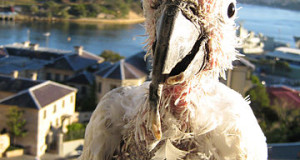Many know the sad story  of the extinction of the USA’s only native breeding parrot, the Carolina Parakeet, Conuropsis carolinensis. The last known specimen of this species died in 1918, in the Cincinnati Zoo. However, a spectacular, pigeon-sized parrot once frequented the mountains of southern Arizona and New Mexico, gorging on pine cones before migrating south to breed.
of the extinction of the USA’s only native breeding parrot, the Carolina Parakeet, Conuropsis carolinensis. The last known specimen of this species died in 1918, in the Cincinnati Zoo. However, a spectacular, pigeon-sized parrot once frequented the mountains of southern Arizona and New Mexico, gorging on pine cones before migrating south to breed.
Last observed in the USA around 1935, the Thick-Billed Parrot ranged from Mexico to Venezuela, but is now largely confined to the Sierra Madre Occidental Mountains in northern Mexico. Brilliant green with a bright red forehead and wing curve, Thick-Billed Parrots dwell at elevations up to 11,500 feet above sea level, and often forage in snow-covered trees.
Pine tree seeds are their main food – so much so that breeding is timed to their availability – and it is for this resource that flocks of over 1,000 foraged for several months each year in our southwestern mountain ranges. Journal entries of naturalists of the time reflect the shock experienced upon encountering a thousand large, gaudy “tropical-looking” parrots in the snows high in the mountains of Arizona. Thick-Billed Parrots also rely heavily upon acorns, and take other seeds, fruits, vegetables and insects as well.
Now drastically reduced in numbers, Thick-Billed Parrots are the subject of a zoo-based Species Survival Plan – a cooperative breeding effort seeking to ensure their survival, and are kept in private aviculture as well. NYC’s Queens Zoo has a nice group in a large, outdoor exhibit – their raucous calls and constant activity render them among the most popular of exhibits.
The USA, especially Florida, is now home to a number of introduced parrot species, many of which breed here (please see my article on Monk Parrots).
You can read about conservation efforts for wild Thick-Billed Parrots in Mexico at:
http://www.worldtwitch.com/thick-billed_parrot.htm
Image referenced from one taken by LTshears in Wikipedia Commons.
 That Bird Blog – Bird Care and History for Pet Birds
That Bird Blog – Bird Care and History for Pet Birds



